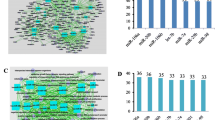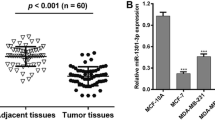Abstract
Objective
The miR-638 acted as a tumor suppressor and E2F transcription factor 2 (E2F2) was a critical regulator in some cancers, while the role of them on stemness of breast cancer stem cells (BCSCs) was rarely detailed. Hence, we focused on exploring the effects of miR-638 and E2F2 on BCSCs stemness.
Methods
The proportion of CD24 −/CD44 + cells of BCSCs was detected by flow cytometry. The target relationship of miR-638 and E2F2 was explored using luciferase assays. The ability of self-renewal, proliferation, and invasion of BCSCs were determined by Mammosphere forming, Cell Counting Kit-8 (CCK-8), colony formation, and transwell assays. Xenograft tumor was established to detect the influence of miR-638 on tumor growth.
Results
miR-638 was down-regulated, while E2F2 was elevated in breast cancer. The E2F2 level was negatively correlated with miR-638. The BCSCs represented higher proportion of CD24 −/CD44 + cells and levels of sex determining region Y-box 2 (SOX2) and octamer-binding transcription factor 4 (OCT4). The miR-638 was down-regulated and E2F2 was increased in BCSCs. MiR-638 could target to E2F2 and decreased the level of E2F2 in BCSCs cells. Overexpression of miR-638 decreased the proportion of CD24 −/CD44 + cells and the levels of SOX2 and OCT4 by inhibiting E2F2. The overexpression of miR-638 also inhibited the abilities of self-renewal, proliferation, and invasion of BCSCs by inhibiting E2F2. The miR-638 overexpression inhibited the breast tumor growth.
Conclusion
MiR-638 represses the characteristics and behaviors of BCSCs by targeting E2F2. MiR-638 may be a potential target for breast cancer therapy.






Similar content being viewed by others
Availability of data and materials
All data generated or analyzed during this study are included in this published article.
References
Jemal A, Siegel R, Ward E, Murray T, Xu J, Thun MJ. Cancer statistics, 2007. Cancer J Clin. 2007;57(1):43–66.
Clarke M. Meta-analyses of adjuvant therapies for women with early breast cancer: the Early Breast Cancer Trialists’ Collaborative Group overview. Ann Oncol. 2006;17(Suppl 10):x59.
Peart O. Metastatic breast cancer. Radiol Technol. 2017;88(5):519m–39m.
Peter V, Dominique B, Ruggero DM, Tsvee L, Mhairi C, Melo JV, et al. Cancer stem cell definitions and terminology: the devil is in the details. Nat Rev Cancer. 2012;12(11):767–75.
Al-Hajj M, Wicha MS, Benito-Hernandez A, Morrison SJ, Clarke MF. Prospective identification of tumorigenic breast cancer cells. Proc Natl Acad Sci USA. 2003;100(7):3983–8. https://doi.org/10.1073/pnas.0530291100.
Hsu HS, Lin JH, Huang WC, Hsu TW, Su K, Chiou SH, et al. Chemoresistance of lung cancer stemlike cells depends on activation of Hsp27. Cancer. 2011;117(7):1516–28. https://doi.org/10.1002/cncr.25599.
Liu R, Shi P, Nie Z, Liang H, Zhou Z, Chen W, et al. Mifepristone suppresses basal triple-negative breast cancer stem cells by down-regulating KLF5 expression. Theranostics. 2016;6(4):533–44. https://doi.org/10.7150/thno.14315.
Bartel DP. MicroRNAs: target recognition and regulatory functions. Cell. 2009;136(2):215–33.
Yan L, Huang X, Huang M, Deng L, Wu Q, Zeng Y, et al. MicroRNA miR-21 overexpression in human breast cancer is associated with advanced clinical stage, lymph node metastasis and patient poor prognosis. RNA. 2008;14(11):2348.
Hossain A, Kuo MT, Saunders GF. Mir-17-5p regulates breast cancer cell proliferation by inhibiting translation of AIB1 mRNA. Mol Cell Biol. 2006;26(21):8191–201. https://doi.org/10.1128/mcb.00242-06.
Li B, Lu Y, Wang H, Han X, Mao J, Li J, et al. miR-221/222 enhance the tumorigenicity of human breast cancer stem cells via modulation of PTEN/Akt pathway. Biomed Pharmacother. 2016;79:93–101. https://doi.org/10.1016/j.biopha.2016.01.045.
Xie Q, Wang S, Zhao Y, Zhang Z, Qin C, Yang X. MiR-519d impedes cisplatin-resistance in breast cancer stem cells by down-regulating the expression of MCL-1. Onco Target. 2017;8(13):22003–13.
Yu ZL, Yu Y, Jia H, Juan Y, Fei WX, Dong TD, et al. miR-638 suppresses cell proliferation in gastric cancer by targeting Sp2. Dig Dis Sci. 2014;59(8):1743–53.
Zhang Y, Zhang D, Jiang J, Dong L. Loss of miR-638 promotes invasion and epithelial-mesenchymal transition by targeting SOX2 in hepatocellular carcinoma. Oncol Rep. 2017;37(1):323.
Ma K, Pan X, Fan P, He Y, Gu J, Wang W, et al. Loss of miR-638 in vitro promotes cell invasion and a mesenchymal-like transition by influencing SOX2 expression in colorectal carcinoma cells. Mol Cancer. 2014;13(1):118.
Tan X, Peng J, Fu Y, An S, Rezaei K, Tabbara S, et al. miR-638 mediated regulation of BRCA1 affects DNA repair and sensitivity to UV and cisplatin in triple-negative breast cancer. Breast Cancer Res. 2014;16(5):435.
Chellappan SP, Hiebert S, Mudryj M, Horowitz JM, Nevins JR. The E2F transcription factor is a cellular target for the RB protein. Cell. 1991;65(6):1053–61.
Stevaux O, Dyson NJ. A revised picture of the E2F transcriptional network and RB function. Curr Opin Cell Biol. 2002;14(6):684–91.
Ren B, Cam H, Takahashi Y, Volkert T, Terragni J, Young RA, et al. E2F integrates cell cycle progression with DNA repair, replication, and G(2)/M checkpoints. Genes Dev. 2002;16(2):245–56. https://doi.org/10.1101/gad.949802.
Gao Y, Ma X, Yao Y, Li H, Fan Y, Zhang Y, et al. miR-155 regulates the proliferation and invasion of clear cell renal cell carcinoma cells by targeting E2F2. Oncotarget. 2016;7(15):20324–37. https://doi.org/10.18632/oncotarget.7951.
Xie L, Li T, Yang LH. E2F2 induces MCM4, CCNE2 and WHSC1 upregulation in ovarian cancer and predicts poor overall survival. Eur Rev Med Pharmacol Sci. 2017;21(9):2150–6.
Song H, Zhang Y, Liu N, Zhang D, Wan C, Zhao S, et al. Let-7b inhibits the malignant behavior of glioma cells and glioma stem-like cells via downregulation of E2F2. J Physiol Biochem. 2016;72(4):733–44. https://doi.org/10.1007/s13105-016-0512-6.
Chung TW, Choi H, Lee JM, Ha SH, Kwak CH, Abekura F, Park JY, Chang YC, Ha KT, Cho SH, Chang HW, Lee YC, Kim CH. Oldenlandia diffusa suppresses metastatic potential through inhibiting matrix metalloproteinase-9 and intercellular adhesion molecule-1 expression via p38 and ERK1/2 MAPK pathways and induces apoptosis in human breast cancer MCF-7 cells. J Ethnopharmacol. 2017;195:309–17. https://doi.org/10.1016/j.jep.2016.11.036.
Rizwan A, Bulte C, Kalaichelvan A, Cheng M, Krishnamachary B, Bhujwalla ZM, Jiang L, Glunde K. Metastatic breast cancer cells in lymph nodes increase nodal collagen density. Sci Rep. 2015;5(1):10002. https://doi.org/10.1038/srep10002.
Qingchuan D, Ping M, Tao W, Weiwei Q, Weijun Q, Fuli W, et al. MicroRNA let-7a inhibits proliferation of human prostate cancer cells in vitro and in vivo by targeting E2F2 and CCND2. PLoS One. 2010;5(4):e10147.
Pan J, Hu H, Zhou Z, Sun L, Peng L, Yu L, et al. Tumor-suppressive mir-663 gene induces mitotic catastrophe growth arrest in human gastric cancer cells. Oncol Rep. 2010;24(1):105–12.
Yuan Y, Shen Y, Xue L, Fan H. miR-140 suppresses tumor growth and metastasis of non-small cell lung cancer by targeting insulin-like growth factor 1 receptor. PLoS One. 2013;8(9):e73604. https://doi.org/10.1371/journal.pone.0073604.
Shen Y, Chen H, Gao L, Zhang W, He J, Yang X, et al. MiR-638 acts as a tumor suppressor gene in gastric cancer. Oncotarget. 2017;8(64):108170–80. https://doi.org/10.18632/oncotarget.22567.
Wei H, Zhang JJ, Tang QL. MiR-638 inhibits cervical cancer metastasis through Wnt/beta-catenin signaling pathway and correlates with prognosis of cervical cancer patients. Eur Rev Med Pharmacol Sci. 2017;21(24):5587–93. https://doi.org/10.26355/eurrev_201712_13999.
Zhang Y, Zhang D, Jiang J, Dong L. Loss of miR-638 promotes invasion and epithelial-mesenchymal transition by targeting SOX2 in hepatocellular carcinoma. Oncol Rep. 2017;37(1):323–32. https://doi.org/10.3892/or.2016.5273.
Li M, Wang J, Liu H. Downregulation of miR-638 promotes progression of breast cancer and is associated with prognosis of breast cancer patients. Oncotargets Ther. 2018;11:6871–7. https://doi.org/10.2147/ott.s182034.
Zhou X, Tao H. Overexpression of microRNA-936 suppresses non-small cell lung cancer cell proliferation and invasion via targeting E2F2. Exp Ther Med. 2018;16(3):2696–702. https://doi.org/10.3892/etm.2018.6490.
Dong Y, Zou J, Su S, Huang H, Deng Y, Wang B, et al. MicroRNA-218 and microRNA-520a inhibit cell proliferation by downregulating E2F2 in hepatocellular carcinoma. Mol Med Rep. 2015;12(1):1016–22. https://doi.org/10.3892/mmr.2015.3516.
Roscigno G, Quintavalle C, Donnarumma E, Puoti I, Diaz-Lagares A, Iaboni M, et al. MiR-221 promotes stemness of breast cancer cells by targeting DNMT3b. Oncotarget. 2016;7(1):580–92. https://doi.org/10.18632/oncotarget.5979.
Zhang Z, Sun L, Zhang Y, Lu G, Li Y. Long non-coding RNA FEZF1-AS1 promotes breast cancer stemness and tumorigenesis via targeting miR-30a/Nanog axis. J Cell Physiol. 2018;233(11):8630–8. https://doi.org/10.1002/jcp.26611.
Osaki M, Okada F, Ochiya T. miRNA therapy targeting cancer stem cells: a new paradigm for cancer treatment and prevention of tumor recurrence. Ther Deliv. 2015;6(3):323–37. https://doi.org/10.4155/tde.14.122.
Zhang Y, Xu B, Zhang XP. Effects of miRNAs on functions of breast cancer stem cells and treatment of breast cancer. Onco Targets Ther. 2018;11:4263–70.
Author information
Authors and Affiliations
Contributions
QYL and PRC conceived and designed the experiments,JQW and LLW analyzed and interpreted the results of the experiments, WEZ performed the experiments.
Corresponding author
Ethics declarations
Conflict of interest
The authors declare that they have no competing interests, and all authors should confirm its accuracy.
Ethical approval
The animal use protocol listed below has been reviewed and approved by the Animal Ethical and Welfare Committee.
Additional information
Publisher's Note
Springer Nature remains neutral with regard to jurisdictional claims in published maps and institutional affiliations.
About this article
Cite this article
Lin, QY., Wang, JQ., Wu, LL. et al. miR-638 represses the stem cell characteristics of breast cancer cells by targeting E2F2. Breast Cancer 27, 147–158 (2020). https://doi.org/10.1007/s12282-019-01002-0
Received:
Accepted:
Published:
Issue Date:
DOI: https://doi.org/10.1007/s12282-019-01002-0




